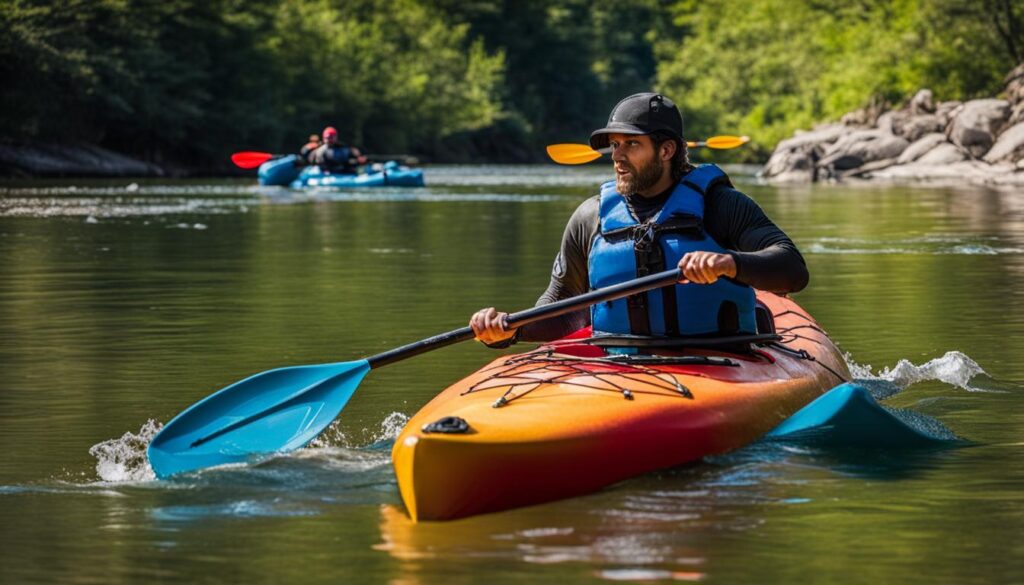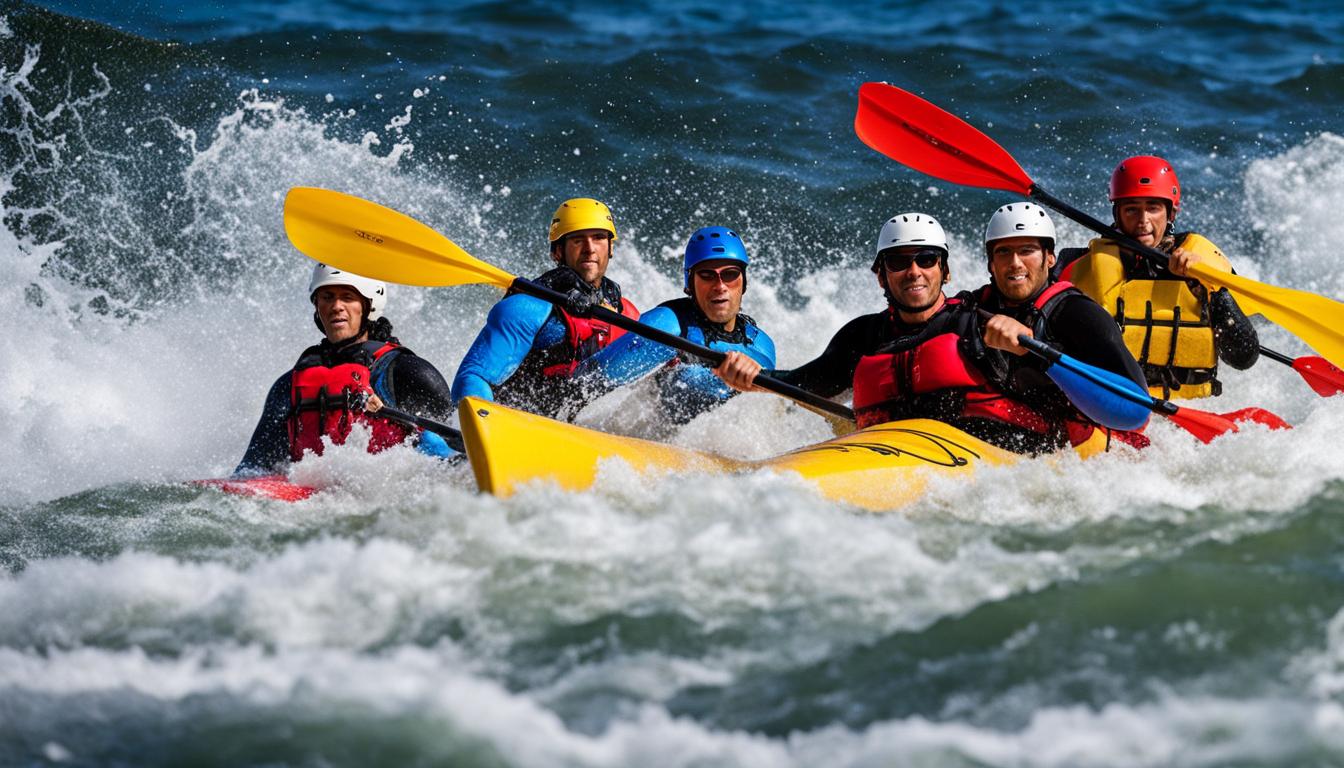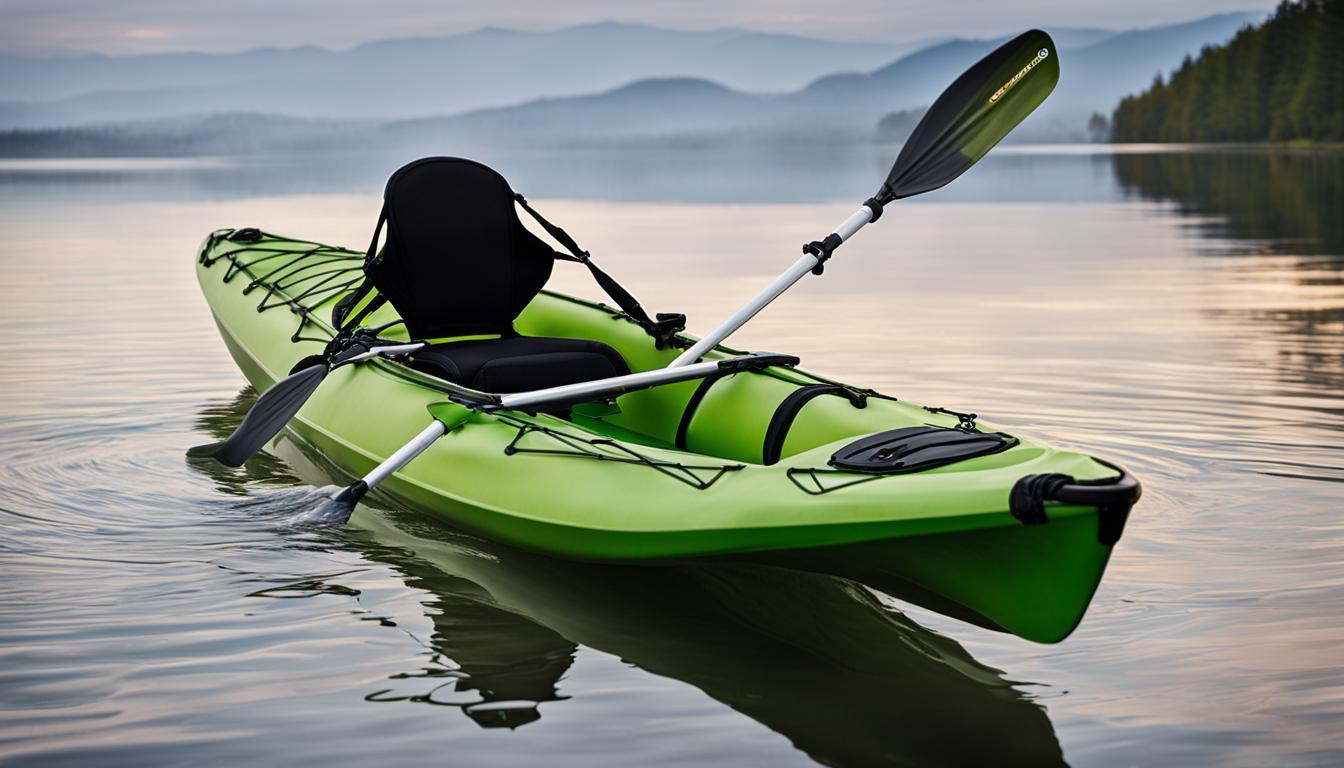Transitioning between kayak materials, from inflatable to hardshell kayaking, can be a transformative experience for outdoor adventurers. For those seeking to take their kayaking to the next level, understanding the benefits and challenges of each type of kayak is essential. In this comprehensive guide, we will explore the process of transitioning from inflatable to hardshell kayaks, providing insights and tips to make your journey seamless and rewarding.
Key Takeaways:
- Transitioning between kayak materials can enhance your kayaking experience
- Inflatable kayaks offer portability and accessibility, while hardshell kayaks provide stability and durability
- Consider your personal goals and preferences when choosing a kayak type
- Master the paddling techniques and safety measures associated with each kayak material
- Ensure proper safety equipment and gear are used for each kayak type
Benefits of Inflatable Kayaks
Inflatable kayaks offer numerous advantages that make them a popular choice among kayakers. These versatile watercraft provide a range of benefits that cater to different paddling preferences and skill levels.
Portability and Storage
One of the key advantages of inflatable kayaks is their portability. They are incredibly lightweight and compact, allowing you to easily transport and store them. When deflated, inflatable kayaks can be rolled up and packed into a small bag, making them convenient for travel and outdoor adventures.
Stability and Maneuverability
Despite their inflatable nature, these kayaks are surprisingly stable on the water. They are designed with multiple air chambers that provide excellent buoyancy and stability, allowing you to confidently navigate various paddling conditions. Additionally, inflatable kayaks are known for their maneuverability, making them ideal for beginners who are still developing their paddling skills.
Affordability
Inflatable kayaks are typically more affordable than their hardshell counterparts. This makes them a cost-effective option for those who want to enjoy kayaking without breaking the bank. Whether you’re a casual recreational paddler or a budget-conscious adventurer, inflatable kayaks offer a great balance of performance and affordability.

Durability
Contrary to popular belief, inflatable kayaks are quite durable. They are made from strong, puncture-resistant materials that can withstand rocks, branches, and other potential hazards on the water. Many inflatable kayaks also come with reinforced bottoms or added protection to enhance their durability, ensuring they can withstand regular use and provide lasting enjoyment.
| Advantages of Inflatable Kayaks |
|---|
| Portability and Storage |
| Stability and Maneuverability |
| Affordability |
| Durability |
Advantages of Hardshell Kayaks
When it comes to kayaking, hardshell kayaks offer a range of advantages that make them a popular choice for outdoor enthusiasts. Whether you’re an experienced paddler or looking to elevate your kayaking experience, here are the benefits of opting for a hardshell kayak:
Enhanced Stability and Control
Hardshell kayaks provide improved stability and control on the water. Their rigid construction allows for better maneuverability, making them suitable for more advanced paddling techniques. Whether you’re navigating through rough waters or practicing intricate maneuvers, a hardshell kayak offers the stability and control you need to stay in command.
Durability and Versatility
Hardshell kayaks are built to withstand the rigors of the water. Made from strong materials such as fiberglass, plastic, or composite composites, they can handle rough conditions and are less prone to damage from rocks or other obstacles. With their durability, hardshell kayaks offer peace of mind, allowing you to explore various waterways without worrying about punctures or leaks. Additionally, hardshell kayaks are versatile and can be used in a wide range of paddling environments, from calm lakes to fast-flowing rivers.
Speed and Efficiency
If you’re looking to cover longer distances with less effort, a hardshell kayak is the way to go. Their sleek design and rigid hull allow for increased speed and efficiency in the water. Whether you’re touring, racing, or simply enjoying a leisurely paddle, a hardshell kayak can help you move effortlessly through the water.
Higher Weight Capacity
For those planning multi-day trips or carrying extra gear, hardshell kayaks offer a higher weight capacity compared to inflatable kayaks. This means you can pack more essentials, whether it’s camping equipment, fishing gear, or supplies for a day trip. With a hardshell kayak, you can embark on extended adventures with confidence knowing that you have the capacity to carry everything you need.
| Advantages of Hardshell Kayaks |
|---|
| Enhanced Stability and Control |
| Durability and Versatility |
| Speed and Efficiency |
| Higher Weight Capacity |
Transitioning from Inflatable to Hardshell Kayaks: Tips and Considerations
Transitioning from an inflatable kayak to a hardshell kayak requires some tips and considerations to ensure a smooth and enjoyable experience on the water. Here are some key insights into mastering different kayak materials and ensuring safety in different kayak types:
1. Practice Paddling Techniques
Switching from an inflatable kayak to a hardshell kayak involves adjusting to different paddling techniques. Hardshell kayaks require more stability and control, so it’s essential to practice proper paddling techniques to maximize efficiency and control. Start by practicing in calm waters and gradually progress to more challenging conditions to build confidence and skill.
2. Consider Kayak Material Choices
When transitioning to a hardshell kayak, it’s important to consider factors such as kayak length, width, and hull design. These factors will influence the kayak’s performance and suitability for different water conditions. Think about your paddling goals and preferences to choose a hardshell kayak that aligns with your needs. Research different materials, such as polyethylene and fiberglass, to understand their benefits and choose the right one for your kayaking adventures.
3. Ensure Safety in Different Kayak Types
Safety should always be a top priority when kayaking, regardless of the kayak type. Familiarize yourself with basic kayak safety guidelines, such as wearing a personal flotation device and knowing how to self-rescue. Additionally, be aware of the specific safety considerations for each kayak type. For inflatable kayaks, ensure proper inflation and regular maintenance to prevent any issues on the water. For hardshell kayaks, focus on technique and control to maintain stability and prevent accidents.
By following these tips and considerations, you can smoothly transition from an inflatable to a hardshell kayak. Remember to practice paddling techniques, consider kayak material choices, and prioritize safety to enhance your kayaking experience.

| Tips for Transitioning between Kayak Types | Mastering Different Kayak Materials | Insights into Kayak Material Choices | Ensuring Safety in Different Kayak Types |
|---|---|---|---|
| – Practice proper paddling techniques | – Familiarize yourself with different kayak materials | – Consider factors like kayak length, width, and hull design | – Follow basic kayak safety guidelines |
| – Gradually progress to more challenging conditions | – Understand the benefits of materials like polyethylene and fiberglass | – Choose a kayak that aligns with your paddling goals | – Ensure proper inflation and regular maintenance for inflatable kayaks |
| – Focus on stability and control with hardshell kayaks | – Practice technique to maximize efficiency and control | – Research different kayak material options | – Prioritize safety measures for each kayak type |
User Experiences: Inflatable vs. Hardshell Kayaks
Hearing from other kayak users can provide valuable insights into the pros and cons of inflatable and hardshell kayaks. Each type of kayak offers unique benefits and drawbacks, and understanding how these factors play out in real-world experiences can help inform your decision. Here, we’ll explore the user experiences with both inflatable and hardshell kayaks, offering insights from kayak users who have firsthand knowledge of each kayak type.
Pros and Cons of Inflatable Kayaks:
- Pros:
- Portability and easy storage
- Stability on the water
- Accessibility for beginners
- Affordability compared to hardshell kayaks
- Cons:
- Less durability than hardshell kayaks
- Potential for punctures or leaks
- Less speed and efficiency in paddling
Pros and Cons of Hardshell Kayaks:
- Pros:
- Enhanced stability and control
- Greater durability and ability to handle rough conditions
- Higher speed and efficiency in paddling
- Higher weight capacity for gear and supplies
- Cons:
- Less portability and more difficult to store
- Higher price point compared to inflatable kayaks
- Requires more experience and skill for optimal performance
“I love my inflatable kayak for its convenience and ease of transport. I can inflate it in minutes and be on the water right away. It’s stable enough for leisurely paddles in calm waters, and I appreciate the affordable price tag. However, when I tried a hardshell kayak during a guided tour, I immediately noticed the difference in stability and control. It felt more sturdy and allowed me to paddle with greater confidence. I could also see the improvements in speed and efficiency. While I enjoy the convenience of my inflatable kayak for quick adventures, I’m considering investing in a hardshell kayak for more advanced paddling experiences.”
Table: Pros and Cons of Inflatable and Hardshell Kayaks
| Inflatable Kayaks | Hardshell Kayaks | |
|---|---|---|
| Portability | ✅ | ❌ |
| Stability | ✅ | ✅ |
| Durability | ❌ | ✅ |
| Speed and efficiency | ❌ | ✅ |
| Affordability | ✅ | ❌ |
| Experience/skill required | ✅ | ❌ |
As the user experience quote indicates, the choice between inflatable and hardshell kayaks often depends on individual preferences and the desired paddling experience. It’s important to consider factors such as portability, stability, durability, speed, and affordability when making your decision. Gathering insights from other kayak users can help you weigh the pros and cons of each kayak type and ultimately choose the one that best suits your needs and goals.
Ensuring Safety in Different Kayak Types
When it comes to kayaking, safety should always be a top priority. Whether you’re paddling in an inflatable or a hardshell kayak, there are certain precautions you should take to ensure a safe and enjoyable experience on the water.
First and foremost, it’s important to familiarize yourself with basic kayak safety tips. This includes wearing a personal flotation device (PFD) at all times, as it can potentially save your life in the event of an accident. Additionally, knowing how to self-rescue and understanding the dangers of cold-water shock are crucial for your safety.
When it comes to inflatable kayaks, proper inflation and maintenance are key. Before setting out on your adventure, ensure that your kayak is fully inflated and secure all valves and closures. It’s also a good idea to periodically check for any signs of wear or damage that could compromise the integrity of the kayak.
For hardshell kayaks, it’s important to practice proper technique and control. These kayaks offer enhanced stability and control, but they can also be more challenging to maneuver for beginners. Take the time to familiarize yourself with the handling characteristics of your kayak and practice in calm waters before venturing into more challenging conditions.
| Type of Kayak | Safety Considerations |
|---|---|
| Inflatable Kayak | – Proper inflation and maintenance – Checking for wear or damage – Secure all valves and closures |
| Hardshell Kayak | – Practice proper technique and control – Familiarize yourself with handling characteristics – Practice in calm waters before challenging conditions |
By adhering to these safety guidelines, both for inflatable and hardshell kayaks, you can enjoy your time on the water with peace of mind. Remember to always be aware of your surroundings, monitor weather conditions, and let someone know your paddling plans before setting out. Happy and safe kayaking!
Conclusion
Transitioning from an inflatable to a hardshell kayak can be an exciting journey for kayak enthusiasts. While inflatable kayaks offer convenience and accessibility, hardshell kayaks provide increased stability and durability, allowing you to take your kayaking experience to the next level. The decision to transition between kayak materials ultimately depends on your personal preferences and goals.
When making the transition, consider factors such as your paddling style, the water conditions you typically encounter, and your skill level. This will help you choose the right kayak that suits your needs. Take the time to practice and familiarize yourself with the different paddling techniques and safety measures associated with each type of kayak. Gradually progressing from calm waters to more challenging conditions will ensure a smooth transition.
Regardless of whether you choose an inflatable or a hardshell kayak, safety should always be your top priority. Familiarize yourself with basic kayaking safety guidelines and ensure you have the necessary safety equipment, such as a personal flotation device and a paddle leash. By adhering to safety protocols and continuously improving your paddling skills, you can confidently and safely enjoy your kayaking adventures.
In conclusion, transitioning from an inflatable to a hardshell kayak opens up new opportunities and challenges for paddlers. Consider your preferences, goals, and skill level when making the transition, and always prioritize safety. With the right kayak and proper technique, you can embark on a more rewarding and enjoyable kayaking experience.
FAQ
What are the benefits of inflatable kayaks?
Inflatable kayaks are easy to transport and store, stable on the water, great for beginners, and more affordable than hardshell kayaks.
What advantages do hardshell kayaks offer?
Hardshell kayaks provide enhanced stability, durability, versatility, speed, and have a higher weight capacity for gear.
What should I consider when transitioning from an inflatable kayak to a hardshell kayak?
Mastering different paddling techniques, practicing in calm waters, considering personal preferences, and ensuring the use of proper safety equipment.
How do inflatable and hardshell kayaks compare based on user experiences?
User experiences vary, with some preferring the convenience of inflatable kayaks and others appreciating the stability of hardshell kayaks. Factors such as paddling style, conditions, and preferences play a role.
What safety considerations should I be aware of for each kayak type?
For inflatable kayaks, proper inflation and maintenance are essential. For hardshell kayaks, practicing proper technique and control is important. Additionally, adhering to basic kayaking safety guidelines is crucial for both types.





